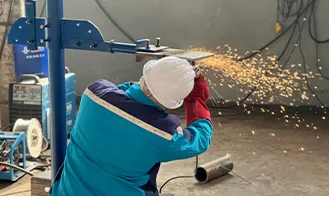Welding Electrode 7016 Manufacturing Process and Quality Standards Overview
The Manufacturing Process of Welding Electrode 7016
Welding has become an indispensable process in various industries, especially in construction, automotive, and heavy machinery. Among the various types of welding electrodes available, the E7016 electrode stands out due to its remarkable properties and performance. This article explores the manufacturing process of welding electrode 7016, detailing its components, production techniques, and the significance of quality control.
The E7016 welding electrode is classified as a low hydrogen rod designed specifically for shielded metal arc welding (SMAW). It is primarily used for welding structural steel and is known for its excellent mechanical properties, including high tensile strength and good impact resistance. The specifications typically designate the electrode's yield strength (70,000 psi) and the type of coating (low hydrogen). The coating is vital as it significantly influences the welding performance and the quality of the weld.
Raw Materials
The production of E7016 electrodes begins with the selection of raw materials. The primary ingredients include steel wire and a combination of various minerals for the coating. The steel wire must have specific chemical compositions to ensure there is minimal hydrogen, which is crucial in preventing cracking in welds. The coating often includes materials such as calcium carbonate, potassium silicate, and other additives that provide desirable properties for welding.
Manufacturing Process
The manufacturing process can be broken down into several key stages
1. Wire Drawing The initial step involves drawing the steel wire into appropriate diameters, typically ranging from 1.6mm to 5.0mm. This process requires precise control of tension and temperature to maintain the integrity of the steel.
welding electrode 7016 factory

2. Coating Application Once the wire is drawn, a mixture of the selected coating materials is applied. This is generally done through a process known as extrusion, where the coating is uniformly applied to the wire. The coating must adhere well to ensure effective protection during the welding process.
3. Drying and Curing After the coating is applied, the electrodes need to be dried and cured. This step is crucial as it helps in achieving the low-hydrogen characteristics of the electrode, making it suitable for critical welding applications.
4. Cutting and Packaging The electrodes are then cut to specific lengths and packaged for distribution. Packaging is a critical step as it must prevent contamination and protect the electrodes from moisture, which can adversely affect performance.
Quality Control
Throughout the manufacturing process, rigorous quality control measures are implemented. This includes testing the tensile strength of the coated electrodes, ensuring uniformity in coating thickness, and inspecting for any defects in the wire. Laboratories conduct metallurgical testing to verify that the finished product meets industry standards.
Conclusion
The manufacturing of welding electrode 7016 is a complex yet well-structured process that ensures high-quality products suitable for various industrial applications. The combination of precise material selection, advanced manufacturing techniques, and thorough quality control results in electrodes that provide excellent performance in demanding welding environments. As industries continue to evolve, the role of high-quality welding electrodes like the E7016 remains pivotal in ensuring structural integrity and safety in construction and fabrication projects.
-
Best MIG Welding No Gas Flux Core Solution – Easy, Portable & Clean WeldingNewsJul.08,2025
-
7018 Welding Rod 3/16 - High Strength, Low Hydrogen Electrodes Wholesale 3/32 Welding Rod 7018 Suppliers & China 7018 AC Welding Rod FactoryNewsJul.08,2025
-
High Quality MIG Aluminium Welding Wire - Wholesale Factory Prices from China SuppliersNewsJul.07,2025
-
High-Quality Gasless Aluminum Welding Wire China Gasless Aluminum MIG Wire SupplierNewsJul.07,2025
-
High Quality Ordinary Welding Rod for Pipes – Reliable China Welding Rod 7016 SupplierNewsJul.06,2025
-
Welding Wire 0.9 mm ER70S-6 Supplier Wholesale Manufacturers & FactoriesNewsJul.06,2025


